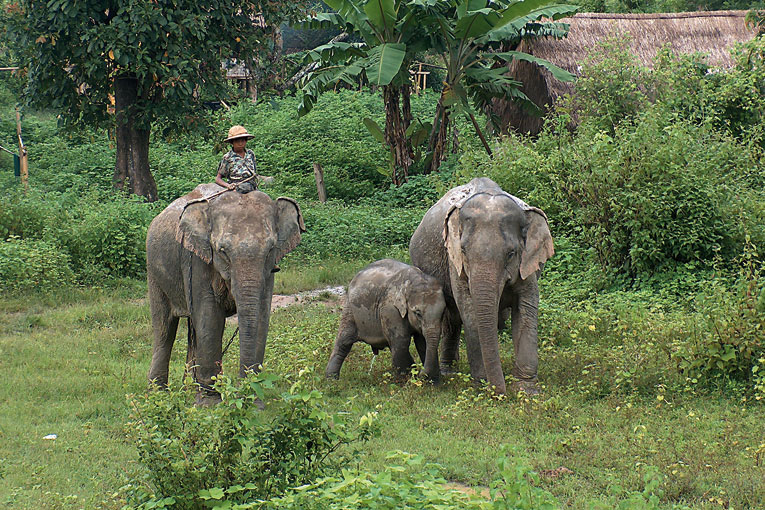
We have been aware from the 19th century of the importance of predation and rivalry between species in nature as predominant forces for natural selection. Darwinian thesis, the great paradigm of life, sets the basis for evolution in the mechanism of natural selection, without which, adaptive changes would not prevail in species and a transforming force in favour of diversity and complexity would not exist. We have to ask ourselves if this perception has not foregrounded the general concept of how nature works and has overshadowed the importance, equally capital, of other biological relations between organisms, especially symbiosis and mutualism. This bias has been reinforced by the audiovisual popularisation that has been fundamental in the last third of the century for the naturalist cultural formation of the population. This popularisation has been conditioned by the interest of documentaries for gutter press.

Photo: Joan Mayol
If evolution is driven by an often ferocius selection, the everyday working of ecosystems depends, even in their basis, on the mutual benefits between species: 70% of vegetables are dependent on the mycorrhiza fungus of the roots, fertility on many plants is conditioned by insects, digestion on most herbivores is based on the bacterial action, etc. This phenomenon is not exclusive of biological evolution, but it also extends to cultural evolution: the most important turning point in human history, above metallurgy, the industrial revolution or cybernetics (the importance of which everybody understands) is the domestication of plants and animals. The domestication of species is key for the success of humankind. Without cattle and farming, we would have already become extinct or we would still live as the rest of primates, surviving in low densities, barely, from hunting and harvesting. Civilisation is not possible without surplus, and the first surpluses in history were achieved by those people who had farming and stockbreeding technology. Animals –apart from food and fibre– provide with workforce and fertiliser. Agriculture won’t go a long way without stockbreeding. The benefit, at least demographic, for domestic species is also evident: the fact that a forest pheasant from south-east Asia (Gallus gallus) have reached the 13.000 millons of individuals, or that a gramineae of wetlands (rice) covers today 180 millions of hectares in the whole world, are examples of a serious biological success. Every cultivated or domesticated species is much more abundant and more widespread than it would be without this relation with ours.

The tool oozies use to control the animals is a spur hook, the choon, although usually voice and leg pressure are sufficient for the animal to understand what is needed from it. A rattle made out of emptied wooden pieces allows for the recovery of the animals that were let free to feed on their own. Every rattle emits a particular sound, so the carer can identify and locate the animal from afar. The working day starts with a relaxing bath for men and animals. / Joan Mayol
Domestication is the first biotechnological success and the most important until today. Regarding the fauna, only a few groups of humans achieved, in particular locations, that aloof or aggressive species became docile, controllable and productive. It is noticeable that in a continent with such a huge diversity of species like Africa’s, cases of domestication have barely occurred (the exception is the helmeted guineafowl); most of the cases took place in Asia, from where it spread over the world. The most evident benefit of domestic animals is the food (meat, milk, eggs) they provide us, but it is by no means the most important: the power outweighs it. Today, living in urban and technological societies, we are not aware of how much people depend on the work of other species. Until only a few decades ago, the whole work of stirring the grounds (cultivate and sow), transport the harvest and humans was mainly animal-powered, and it still is for a considerable part of the humanity. The debt of gratitude that we have toward cattle is considerable; the authentic automobiles are the equids, the bovids and the camelids. It could be interesting to analyse a singular case, the biggest species ever domesticated, that has represented for humanity two first-rate roles: tanks and tractors.
«If evolution is driven by an often ferocious selection, the everyday working of ecosystems depends, even in their basis, on the mutual benefits between species»
The Asian elephant (Elephas maximus) is placed in an incipient state of domestication. Most of the domesticated species are morphologically differentiated from their wild ancestors and have changed in a considerable way due to artificial selection. This is not the case of the big pachyderm: wild and domestic animals are similar, in fact still today wild elephants are captured and tamed, although the captives procreate normally, and to tame an elephant with a domesticated mother is often regarded as an easier task. As we will detail later, many of the elephants used today in forestry works roam free at night so they can feed themselves, and it is not strange that domesticated female elephants get impregnated by wild males. Accidents, sometimes of mortal consequences, are not unusual either, caused by temporarily aggressive domesticated animals, especially some males with oestrus-related behaviour (the musth), which are chained at the first sight of this behaviour.

It is the job of the elephants to pull logs and pile them up on the loader. Males use their tusks to move the logs. / Joan Mayol
The civil work of elephants
Some evidences suggest that the domestication of the species took place in India, before the second millennium before Christ, to make good use of their strength in agrarian and forestry works. As we have seen, this practice goes on in a similar way to the original in the extraction of the valuable teak wood from the mountain forests in Burma.
Elephants are hugely appreciated, not just for their strength but also for their agility: in a slow but safe manner, they are able to climb considerably steep slopes, and therefore they work in places inaccessible even for modern machinery. And the cliché about their clumsiness is completely false: a friend of mine told me how surprised he was when he saw an elephant moving with care and with a certain speed through a traffic jam in Bangkok, without causing any problem to cars nor people.
They need an important investment, for fourteen years are needed to the complete domestication, which starts at the age of four. As it is logical, they need the constant attention of their carers, the oozie (Burma word equivalent to the Indian mahout), who are not their owners. Most of the beasts belong to the government or rich urban owners.
«Elephants are hugely appreciated: they are able to climb considerably steep slopes»
Elephants work five to six hours a day, the oozie many more. Their working day starts by the recovering of the animal that has spent the night free feeding in the jungle. That requires effort, time and skill, because the beast, despite being fastened, might be more than 10 km away looking for grass. The carer follows the trail and listens for the wooden rattle, which has a specific sound for each animal. Once located, they have to pamper the elephant so it lets them ride it to the camp, where the working day usually starts with a nice bath. After that, back to work, where they basically push and pull trunks to the loading platform or to the fluvial route, where the logs will be sent down the river.

Sensitive spots on the body of an elephant, where the choon’s pressure delivers different responses. The points with a double circle are very delicate, and over-spurring can lead to the death of the animal. / Extret de Toke Gale, 1974
Elephants are driven using the voice, the pressure of legs behind the ears and also with a convincing tool, the choon, a kind of handheld spur with different possibilities for persuasion (hammer, hook or spike). The Indian mahoots have a map with the points on the body of the animal where they can achieve several different responses (excitement, reserve, march, backward movement, immobility, sitting down, etc). They have to be careful, as 17 of these points are fatal and an excessive pressure can kill the beast.
The level of relationship between elephants and their carers is highly noticeable. This is often a hereditary job and it is not surpising to see a teenager oozie take care of a young elephant, so his working life will run alongside his father. A great level of confidence, complicity and intimacy is established in the relationship between both of them, maybe not existing in any other interspecific relation (with the exception of lichens). During their lives, they will spend tens of thousands of hours of direct physical contact. They say that the animal does not accept any other oozie, were his one to die. It is an extraordinary symbiosis.
Today it is estimated that more than ten thousand elephants are still working in the Asian forests. From the environmental point of view, it is considered positive: they make unnecessary the opening of tracks in great areas of the jungle, they have a pace of work that makes sustainable forestry uses possible, and as we will discuss later, it can contribute to the preservation of the species. Many of them have changed careers, following the sign of the times, to the tertiary sector; and provide stroll services to tourists, complementary activities, in fact, to the forestry work in many regions of the Far East.
War elephants: from Alexander the Great to the Second World War
Not every elephant use has been peaceful. Everybody knows they took part in the Punic Wars and that Hannibal managed to enter in Italy, going through Iberia and the Alps, with some elephants, used as war weapon (and probably an advertising sttrategy). The truth is that the first contact of Europeans with elephants happened a century before: Alexander the Great confronted them in the invasion of Persia (a few tens), and it seems that the big quantity that the Indian army had (some sources talk about 6.000 war elephants in the bank of the Ganges river, that the Macedonian refused to cross) was decisive for the withdrawal of the Greeks (they still took some advantage from it, bringing back to the West some animals and the techniques to control them).
Full article available in Spanish and Catalan.
Bibliography
IUCN, 2012. IUCN Red List of Threatened Species. 2012 version. IUCN. Cambridge.
PNUMA-CMCM, 2009. Estado de conservación y comercio de elefantes. PNUMA-CMCM.
Toke Gale, U., 1974. Burmese Timber Elephant. Trade Corp. Yangon, Birmania.
Williams, J. H., 2009. Bill de los elefantes. Ediciones del Viento. A Coruña.





